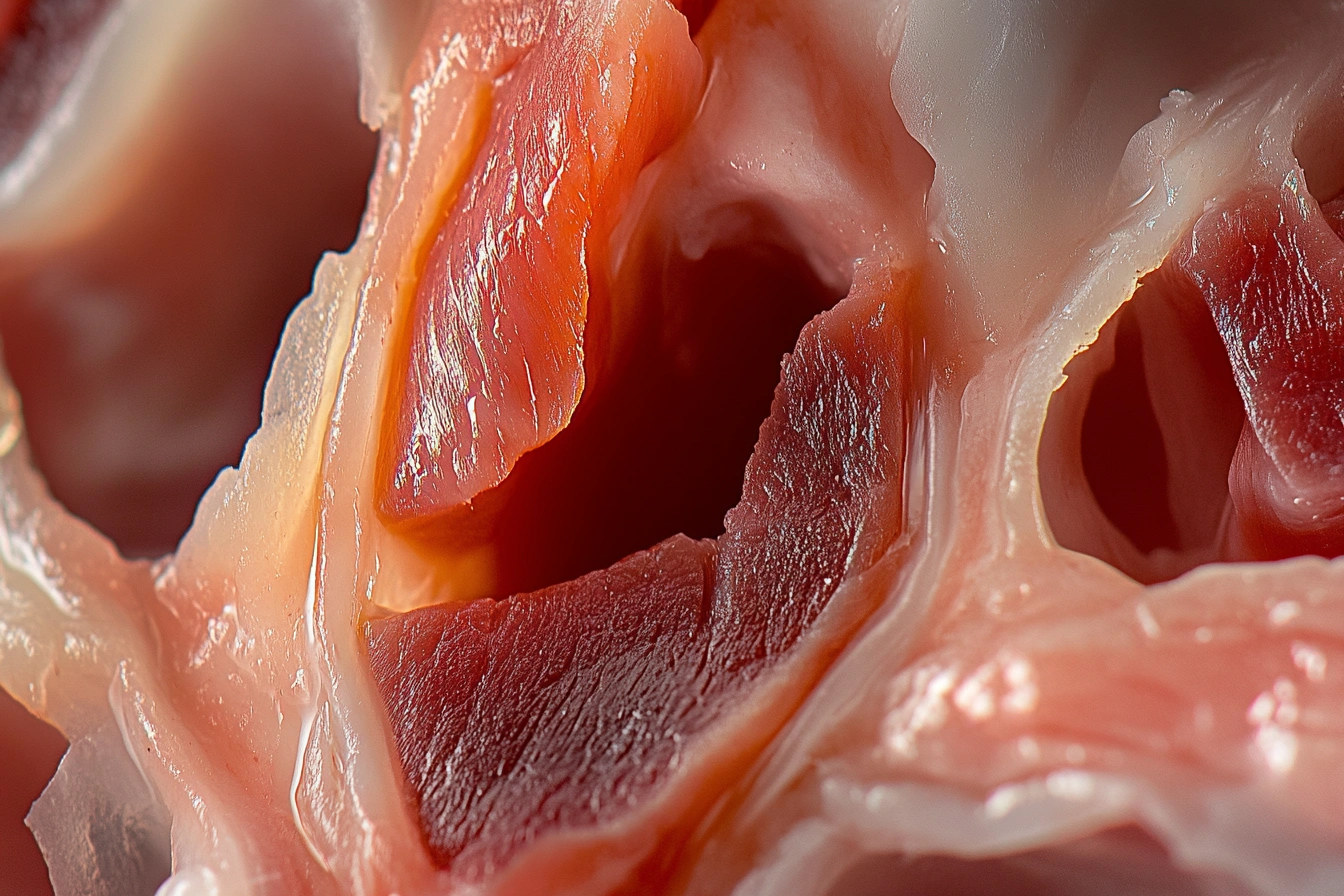Understanding Beef Tendon
1. Introduction
Beef tendon is a prized ingredient in many cuisines, known for its unique texture, rich collagen content, and health benefits. Though it may seem unfamiliar to some, it is a staple in Asian, European, and traditional culinary practices.
When raw, beef tendon is tough and fibrous, but when slow-cooked, it transforms into a soft, gelatinous texture that absorbs flavors beautifully. It is commonly used in soups, stews, and braised dishes, adding depth and richness to broths and sauces.
Beyond its culinary appeal, beef tendon is highly valued for its nutritional benefits. It is a low-fat, high-protein food that is rich in collagen, which supports joint health, skin elasticity, and digestion.
This article will explore:
- What beef tendon is and how it’s used in global cuisines.
- The impressive health benefits of beef tendon.
- How to cook it properly to bring out its best texture and flavor.
Table of Contents
2. What is Beef Tendon?
📌 Definition and Source
Beef tendon is a connective tissue found in cows, primarily from the legs and shoulders. It plays a crucial role in supporting muscles and joints, making it dense and fibrous when raw.
📌 Appearance and Texture
- Raw Beef-Tendon: Firm, pale, and fibrous.
- Cooked Beef Tendon: Transforms into a gelatinous, tender consistency with a rich, slightly chewy bite.
Since beef tendon contains little to no muscle fibers, it requires long, slow cooking to break down into a melt-in-your-mouth texture.
📌 Culinary Use Across Different Cuisines
✅ Chinese Cuisine – Braised beef-tendon is a delicacy in Cantonese and Sichuan dishes, cooked with soy sauce, star anise, and spices.
✅ Japanese Cuisine – Gyusuji Nikomi (beef tendon stew) and ramen toppings feature beef tendon simmered for hours to create rich umami flavors.
✅ Vietnamese Cuisine – A key ingredient in Pho Bo (Vietnamese beef noodle soup), where it adds gelatinous richness to the broth.
✅ Western Cuisine – Used in bone broths and stews for its ability to thicken and enrich stock with collagen.
With its versatility and depth of flavor, beef tendon is a hidden gem in global gastronomy.
3. Nutritional Benefits of Beef-Tendon
📌 High Collagen Content – Supports Joint Health & Skin Elasticity
Beef tendon is one of the richest natural sources of collagen, a protein essential for:
✔ Joint Health – Helps lubricate joints and reduce inflammation.
✔ Skin Elasticity – Collagen improves skin hydration, reducing wrinkles.
✔ Stronger Hair & Nails – Supports hair growth and nail strength.
📌 Low in Fat, High in Protein – Ideal for a Lean Diet
Unlike fatty cuts of beef, beef-tendon is naturally low in fat while being high in protein, making it a great choice for:
✔ Muscle Building – Provides essential amino acids for muscle recovery.
✔ Weight Management – High protein keeps you full longer with fewer calories.
📌 Rich in Essential Nutrients – Iron, Zinc, and B Vitamins
Beef tendon contains:
✔ Iron – Supports red blood cell production and prevents fatigue.
✔ Zinc – Boosts immune function and wound healing.
✔ B Vitamins – Helps with energy production and brain health.
📌 Health Benefits of Consuming Collagen
✅ Joint Health & Mobility
- Regular consumption may help reduce arthritis symptoms and improve flexibility.
✅ Gut Health & Digestion
- Collagen supports a healthy gut lining, preventing leaky gut syndrome.
✅ Youthful Skin & Anti-Aging Properties
- Helps maintain firm, hydrated skin, reducing wrinkles and fine lines.
With its nutrient density and health benefits, beef tendon is an excellent addition to a balanced diet, whether for fitness, skincare, or overall well-being.

How to Cook and Enjoy Beef Tendon
4. How to Prepare and Cook Beef Tendon
📌 Cleaning and Prepping Beef-Tendon
Before cooking, beef tendon requires proper cleaning to remove any excess fat and impurities:
1️⃣ Rinse the tendon under cold water to remove surface residue.
2️⃣ Trim any excess fat with a sharp knife for a cleaner texture.
3️⃣ Blanch in boiling water for 5–10 minutes to remove any unwanted odors, then discard the water.
📌 Best Cooking Methods for Beef-tendon
✅ Boiling and Simmering (Traditional Method)
- Best for soups and stews like pho or braised dishes.
- Cooking time: 3–4 hours over low heat until soft.
- Pro tip: Add spices like ginger, star anise, and cloves for extra depth.
✅ Pressure Cooking (Faster Method)
- Cuts cooking time down to 40–60 minutes.
- Perfect for braised beef-tendon dishes.
- Ensure natural pressure release for best texture.
✅ Slow Cooking (Best for Broths & Collagen Extraction)
- Ideal for bone broths and gelatin-rich stocks.
- Cook for 8–10 hours for maximum collagen release.
- Adds depth and silkiness to soups.
📌 How to Tell When It’s Done
✔ Tender and gelatinous texture (not chewy or tough).
✔ Can be easily pierced with a chopstick or fork.
✔ Absorbs sauce flavors well in braised dishes.
5. Popular Beef Tendon Recipes
Beef tendon is used in many global cuisines, creating rich and flavorful dishes.
🥢 Chinese-Style Braised Beef-Tendon
- Slow-cooked in soy sauce, ginger, star anise, and Shaoxing wine.
- Best served with rice or noodles.
🍜 Japanese Beef-Tendon Stew (Gyusuji Nikomi)
- Simmered with miso, sake, and mirin for a savory-sweet umami flavor.
- A common topping for ramen or a side dish.
🍲 Vietnamese Pho with Beef-Tendon
- Cooked in a fragrant beef broth with cinnamon, star anise, and cloves.
- Adds a rich, gelatinous texture to the noodle soup.
🌶️ Spicy Beef-Tendon Curry
- Common in Japanese and Indian curries.
- Slow-cooked to absorb aromatic spices like cumin, turmeric, and garam masala.
🥣 Collagen-Rich Beef-Tendon Soup
- Perfect for cold weather or post-workout recovery.
- Simmered with bone broth for maximum collagen extraction.
Each of these dishes showcases the versatility of beef tendon across different cuisines!

6. Where to Buy and Store Beef -Tendon
📌 Where to Buy Beef-tendon
Beef tendon is commonly available at:
✔ Asian Grocery Stores – Found in the fresh or frozen meat section.
✔ Butcher Shops – Can be special-ordered if not readily available.
✔ Online Meat Suppliers – Some offer pre-cleaned and pre-cut beef tendon.
📌 How to Store Beef -endon
✅ Refrigeration:
- Store raw beef-tendon in the fridge for up to 2 days.
✅ Freezing:
- Best for long-term storage (up to 6 months).
- Wrap tightly in plastic or vacuum-seal before freezing.
📌 How to Tell If Beef-Tendon Has Spoiled
🚫 Slimy or sticky texture – Indicates bacterial growth.
🚫 Unpleasant sour smell – A sign of spoilage.
🚫 Discoloration (gray or greenish tint) – Should not be consumed.
Proper storage ensures freshness and preserves its unique texture.
7. Frequently Asked Questions
Is beef tendon healthy?
Yes! It is high in collagen, low in fat, and packed with protein and essential nutrients like iron and zinc.
How do you make beef tendon tender?
The best methods are slow cooking, boiling, or pressure cooking for at least 2–4 hours until gelatinous and soft.
Can you eat beef-tendon raw?
No, beef-tendon must be cooked to break down its tough connective tissue into a soft, edible texture.
What does beef-tendon taste like?
It has a mild, neutral flavor but absorbs sauces and broths well. The texture is chewy, gelatinous, and rich.
How long should you cook beef tendon?
- Simmering: 3–4 hours
- Pressure cooking: 40–60 minutes
- Slow cooking: 8+ hours for broth extraction
8. Conclusion
Beef tendon is a highly nutritious, flavorful, and versatile ingredient that has been enjoyed for centuries in various global cuisines. While it may not be as commonly used in Western cooking, it is a staple in Asian dishes, particularly in Chinese, Japanese, and Vietnamese cuisine, where it is slow-cooked to perfection.
One of the most significant benefits of beef tendon is its high collagen content, which plays a crucial role in joint health, skin elasticity, and digestion. Unlike fatty cuts of meat, beef tendon is low in fat but high in protein, making it a great option for those looking for a lean yet nourishing source of protein. It also contains essential nutrients like iron, zinc, and B vitamins, which contribute to overall health and well-being.
Cooking beef-tendon requires patience, as it is a tough connective tissue that needs long, slow cooking to break down into a tender, gelatinous texture. Some of the best methods include boiling, braising, slow cooking, and pressure cooking. When properly prepared, it becomes soft and flavorful, absorbing the spices and seasonings in dishes like Chinese braised beef-tendon, Japanese gyusuji nikomi, and Vietnamese pho.
For those new to beef tendon, it is readily available in Asian grocery stores, butcher shops, and online meat suppliers. Proper storage is essential—it can be refrigerated for up to two days or frozen for up to six months.
Whether you’re looking to enhance your diet with collagen-rich foods, explore new culinary flavors, or simply enjoy a comforting, hearty dish, beef tendon is a fantastic ingredient to try. Give it a chance in your next stew, soup, or noodle dish, and experience its unique texture and health benefits firsthand! 🍲😊

